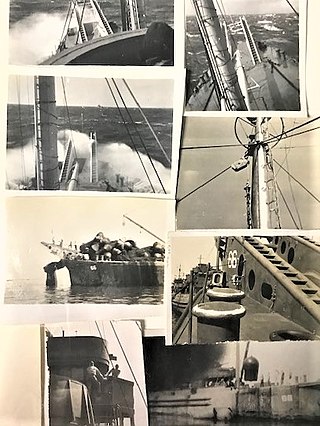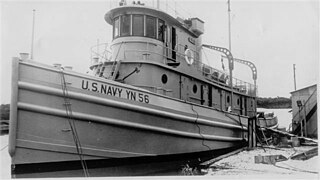
USS Sphinx (ARL-24) was laid down as a United States Navy LST-542-class tank landing ship but converted to one of 39 Achelous-class repair ships that were used for repairing landing craft during World War II. Named for the Sphinx, she was the only US Naval vessel to bear the name.

USS Oriole (AM-7) was a Lapwing-class minesweeper acquired by the U.S. Navy for the dangerous task of removing mines from minefields laid in the water to prevent ships from passing.

USS Butternut (AN-9/YN-4/ANL-9/YAG-60) was laid down as a yard net tender on 11 March 1941 at Houghton, Washington, by the Lake Washington Shipyard; launched on 10 May 1941; and placed in service at the Puget Sound Navy Yard on 3 September 1941.
USS Marietta (YN-101/AN-82) was a Cohoes-class net laying ship commissioned at the end of World War II. Post-war she was deactivated, but then recommissioned during the Korean War era. After that service, she was struck from the Navy List and transferred to the Venezuelan Navy in 1962.

USS Snowbell (YN-71/AN-52) was a Ailanthus-class net laying ship which served the U.S. Navy during World War II. She operated in the Pacific Ocean until she was destroyed by Typhoon Louise off Okinawa, 9 October 1945.
USS Chinquapin (YN-12/AN-17) was an Aloe-class net laying ship built for the United States Navy during World War II. Originally ordered as USS Fir (YN-2), she was renamed and renumbered to Chinquapin (YN-12) in October 1940 before construction began. She was launched in July 1941, and completed in October 1941. Placed in service at that time without being commissioned, she was commissioned in January 1943, and decommissioned in March 1946. She was placed in reserve at that time and scrapped in 1976.

USS Hoptree (AN-62/YN-83) was a Ailanthus-class net laying ship that served in the U.S. Navy during World War II. Hoptree performed her tour of duty in the Pacific Ocean and, post-war, she was decommissioned and sold.
USS Viburnum (AN-57/YN-76) was a Ailanthus-class net laying ship which served with the U.S. Navy in the Pacific Ocean theatre of operations. While operating in the Caroline Islands, she was severely damaged when struck by what appeared to be a Japanese torpedo. However, she continued her work as well as she could, and, when she returned to the United States, she was considered too damaged to repair. She was sold in her damaged condition, and was eventually scrapped.
USS Anaqua (AN-40/YN-59) was an Ailanthus-class net laying ship which served with the United States Navy in the Western Pacific Theater of Operations during World War II. She served the U.S. Pacific Fleet with her protective anti-submarine nets, and returned home safely after the war.

USS Teak (AN-35/YN-30) was an Aloe-class net laying ship which served with the U.S. Navy in the Pacific Ocean theatre of operations during World War II. She was assigned to serve the U.S. Pacific Fleet with her protective anti-submarine nets and earned two battle stars and other commendations for her bravery.

USS Teaberry (AN-34/YN-29) was an Aloe-class net laying ship which was assigned to serve the U.S. Pacific Fleet during World War II with her protective anti-submarine nets and, at war's end, returned home safety with one battle star to her credit. She was later reactivated for duty during the Korean War era.

USS Elder (AN-20/YN-15) was an Aloe-class net laying ship which was assigned to serve the U.S. Navy during World War II with her protective anti-submarine nets.

USS Eucalyptus (YN-11/AN-16) was an Aloe-class net laying ship built for the United States Navy during World War II. She was launched in July 1941, and completed in October 1941. Placed in service at that time without being commissioned, she was commissioned in May 1942, and decommissioned in 1946. She was placed in reserve and later scrapped in 1976.
USS Ebony (YN-10/AN-15) was an Aloe-class net laying ship built for the United States Navy during World War II. She was launched in June 1941, and completed in September 1941. Placed in service at that time without being commissioned, she was commissioned in May 1942, and decommissioned in March 1946. She was placed in reserve in 1946 and scrapped in 1976.
USS Buckthorn (YN-9/AN-14) was an Aloe-class net laying ship built for the United States Navy during World War II. Originally ordered as USS Dogwood (YN-3), she was renamed and renumbered to Buckthorn (YN-9) before construction began in December 1940. She was launched in March 1941, and completed in September 1941. Placed in service at that time without being commissioned, she was commissioned in December 1942, and decommissioned in August 1947. She was placed in reserve in 1947 and scrapped in 1976.
USS Catalpa (AN-10/YN-5) was an Aloe-class net laying ship which was assigned to serve the U.S. Navy ships and harbors during World War II with her protective anti-submarine nets.
USS Boxwood (YN-3/AN-8) was an Aloe-class net laying ship which was assigned to serve U.S. Navy ships and harbors during World War II with her protective anti-submarine nets.

USS Pinon (AN-66/YN-87) was a Ailanthus-class net laying ship which was assigned to protect U.S. Navy ships and harbors during World War II with her anti-submarine nets.
USS Passaconaway (YN-111/AN-86) was a Cohoes-class net laying ship built for the United States Navy during World War II. She was commissioned in April 1945 and spent her entire career in the Pacific Ocean. She was decommissioned in December 1946 and placed in reserve. She was sold to the Dominican Republic in September 1976 as patrol vessel Separación (P208). As of 2007, Separación remained active in the Dominican Navy.

USS Wapello (YN-56), later YNT-24, was a United States Navy net tender in commission from 1941 to 1946.











